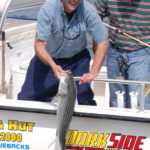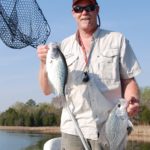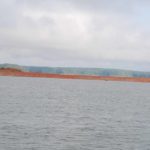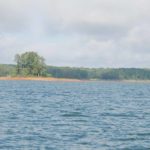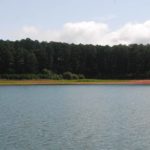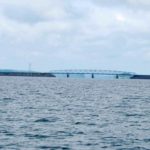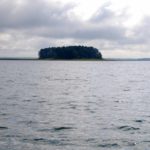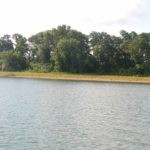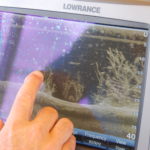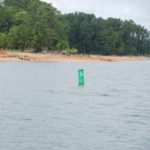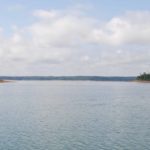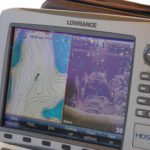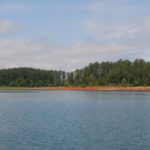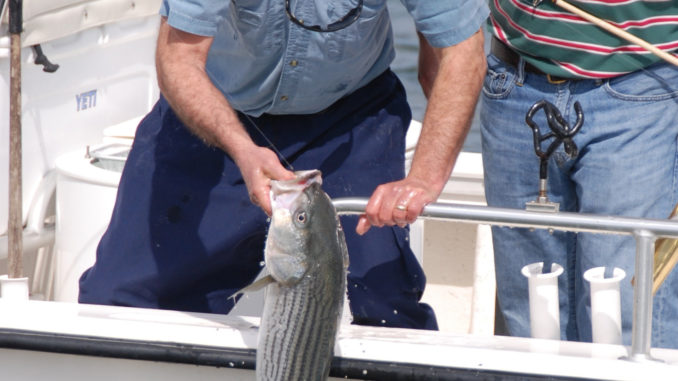
Clarks Hill, aka Lake Thurmond, offers great fishing for a number of species in the fall. Here’s where to find them.
At almost 71,000 acres, Clarks Hill Reservoir, the largest manmade body of water east of the Mississippi River, is still surprisingly undeveloped compared to many of the other impoundments across South Carolina.
Clarks Hill, or Lake Thurmond if you prefer, was built between 1946 and 1954, just a few years before Lake Hartwell and some 30 years before Lake Russell, the other two impoundments upstream on the Savannah River system.
As a fishery, Clarks Hill has a reputation as a better-than-average destination for a number of species. Professional bass tours frequently make stops there, and a growing number of crappie and catfish tournament circuits are also becoming regular visitors. One of the more sought-after species, at least as far as recreational anglers are concerned, are striped bass. Stripers and their test-tube cousins, hybrid striped bass, were first introduced into Clarks Hill during the late 1960s. The fishery was to their liking, and the lake produced a state-record striper in 1993 that wasn’t topped for eight years.
William Sasser, who grew up around the lake, has been a fishing guide there for most of his adult life. He’s even further invested into the life of the lake by purchasing and revitalizing two nearby bait and tackle shops. Sasser opened his playbook and offered a look at some of his go-to locations to catch a number of different species in October.
1 Camel Humps
33 41 545 N/82 12 948 W
Small shoal islands at the mouth of Howell Branch resemble a camel’s branch on a depthfinder screen. Although water as deep as 70 feet can be found around them, Sasser suggests searching for striped bass and hybrids at 50 feet or less.
“During October, stripers and hybrids will be caught here on down-lines 30 to 40 foot deep using live herring,” he said. “It’s real close to the river channel here. There’s a bunch of pockets and coves along the either side of the long point that sticks out into the lake. Blueback herring get trapped in those pockets, and you can catch a bunch of stripers during the early morning, right after daylight up until about 9 o’clock.”
Sasser will motor through the area looking for concentrations of baitfish on his graph. A lot of times, he won’t see fish here until he starts fishing. However, the presence of baitfish is almost a guarantee of fish nearby.
“Put six poles in the water and just drift out of the cove,” he said. “They will find you.”
2 Bass Alley
33 42 946 N/82 14 953 W
Although most anglers make little if any distinction in the way they fish for striped bass and hybrid striped bass, Sasser said this is a great place to catch hybrids. Water depths range anywhere from 30 to 70 feet. Most of the fish will be found holding around 30 to 40 feet deep.
“Right here, on the coordinates, we’re on an underwater point,” said Sasser. “You want to fish either side of the point; I always fish the downwind side of anything I’m fishing. The fish seem to hide on the downwind side of structure to get bait fish coming across the top of it.”
Sasser said fishing long points and humps is a typical fall pattern, using the wind to push bait into coves and pockets and then picking off the fish on down-lines. He also offered that a lot of surface schooling occurs in the general vicinity.
“You’ll find more schooling activity either further in the cove or further out of the cove,” he said. “In October, I’d say probably more out of the cove toward the main lake from this point.”
3 Crappie Tree
33 43 259 N/82 15 263 W
Clarks Hill has been renowned for its striped bass and hybrid fishing since way back in the 1970s. However, its abundant crappie make the sprawling lake a multi-faceted fishery, and Sasser spends many hours creating brushpiles to provide areas for crappie to congregate. This is one of those areas.
“This is a single, but very large, hardwood tree that I put out,” said Sasser. “It attracts a lot of crappie during the fall. Fish about 20 foot deep with small minnows or jigs, just make sure you match the water color with the jig color. In the fall, that’s more of a brownish or yellow or orange.”
Even when fishing for crappie, Sasser takes a striper fishing approach to put fish in the boat. He prefers to anchor his boat directly upwind of the spot, then let the boat drift back until he’s directly over the structure. Then he deploys light tackle rods straight down in a mini-version of his down rod fishing.
“The fall is probably the best time of the year to catch crappie at Clarks Hill,” Sasser said. “You’ll catch nothing or you’ll catch everything if you hit the right tree. The crappie generally will be bigger than in the spring time. Everything is a pound, pound-and-a-half, even 2 pounds. It’s bigger fish and in larger numbers, if you’re in the right place.”
4 Gordon Shoals
33 42 154 N/82 18 853 W
If casting topwater baits to schooling largemouth bass is more your style of fall fishing at Clarks Hill, then you may want to skip this spot, which is in the middle of Georgia Little River, straight out from Fort Gordon and offers shallow water surrounded by deep water.
“It’s a series of shoals, five underwater islands, right here,” Sasser said. “In the normal fall pattern, the fish will be near the surface. You’ll see largemouth breaking on top of the water. Evenings are really good here.”
Sasser’s preferred baits are either a Lucky Craft Gunfish or a Sammy. He said lighter colors work better, and fish have shown that they often prefer one bait over another on certain days, so it pays to change baits if you’re not getting enough action. Other times of the day, Sasser has also had success using jigs in this location.
“The shoals right now are around 5 foot deep on the top of the hump,” Sasser said. “You’ll find a lot of hydrilla in the shallow water, so working a mop head jig across the top can also work real well,” he said.
5 Mistletoe Area
33 40 971 N/82 22 749 W
Moving up Little River, Sasser stops at another good bass-fishing site on the other side of the bridge. This location is straight across from Mistletoe State Park, just past Graves Creek, right before you come to White Bass Island. It combines shallow water near deep water providing largemouth, a good location to ambush passing baitfish.
“This is basically a really big flat area with some little valleys crossing it,” Sasser said. “During the fall, largemouth bass will be on this location chasing threadfin shad and herring. If there’s a little chop on the water early in the morning, the topwater fishing in this location can be phenomenal. Then later on in the day, you can come back and fish a mop head jig across the top of it and finish out your limit.”
6 Donna’s Crappie Spot
33 40 845 N/82 22 698 W
Sasser and his wife, Donna, sunk a huge tree six years ago that produces a lot of large crappie every fall.
“The water depth, with the current lake level 10 feet below normal pool, puts the tree sitting in 33 feet of water right now. It would normally be in 43 feet of water,” Sasser said. “The tree comes to within 10 feet of the surface. You’ll have to fish off and down the side of it right now. When the lake is normal level, I do better fishing near the top of the tree.”
Down-rodding for crappie isn’t the only game in town at this or any of Sasser’s other planted fish havens. He said he can catch an abundance of species depending on how he fishes them and what he fishes with.
“You definitely will find hybrids and stripers hanging around a single tree out by itself,” he said. “You’ll also find largemouth, catfish — both channel catfish and flathead catfish, as well as bluegill and crappie.”
7 Buoy L-15
33 41 377 N/82 17 847 W
Downstream, toward the mouth of Georgia Little River, this is another place where Sasser targets stripers and hybrids. He said the fish really key in on migrating schools of bait along long points upstream from, downstream from and on the point where L-15, a green buoy marking the Little River channel, is located.
Sasser expects to find fish up and down the water column, but he said fish are easier to locate when they are orienting to the bottom.
“This spot has three long points running parallel to each other,” he said. “I try to find fish on the bottom using my graph. Fish on the bottom are a whole lot easier to get to feed than suspended fish, so I look first on the bottom. Once they’re marked, I just stay off the downwind side of each point and fish straight down. Once they start feeding, the smaller fish, especially hybrids, will come up, but the larger ones will hang back near the bottom.”
Sasser said he regularly catches hybrids from four to eight pounds on this spot, along with stripers between seven and 12 pounds.
8 No-Name Creek
33 42 542 N/82 16 865 W
Before heading out of Little River, Sasser steers northeast and motors to the back of a “no-name” creek for one more shot at fall crappie fishing. This spot is one he made using one large hardwood tree, sinking it in water more than 20 feet deep.
“Yeah, this is another tree we put down,” said Sasser. “It’s a great fall fishing spot. It’s got a lot of good sized crappie on it. Fish small minnows about 20 foot down. With the water levels we’ve had this fall. I’d fish near the bottom to catch larger crappie. The smaller ones will be up in the tree a little bit.
In days gone by, Clarks Hill boasted a strong population of both white and black crappie. Sasser said these days, catching a white crappie is a pretty rare event; he catches one white crappie to every 50 black crappie.
“When I was a kid, there was way more white crappie, but a white crappie on Clarks Hill is pretty rare now,” he said. “Usually, if you catch one though, it’s pretty good size.”
9 Monkey Island
33 41 155 N/82 14 057 W
According to Sasser, this island got its name when a circus leaving Augusta, Ga., back in the 1950s camped out in the area, and some monkeys got out of their cages and sound up being caught on a series of islands. The name stuck.
Sasser doesn’t “monkey around” while striper fishing here. The area is the junction of Keg Creek, Georgia Little River and the Savannah River, a series of underwater points where striped bass chase bait in the fall.
“Like the other spots, you’re going to be looking for baitfish,” said Sasser. “In this part of the lake, they might be a little deeper, even during October. If we’ve had a hot summer, the baitfish still could be 70 to 80 feet deep, so if you see bait 70 to 80 feet deep, that’s where the stripers are going to be.”
William Sasser of Sasser’s Guide Service can be contacted at 706-589-5468, or at one of his bait shops, the Herring Hut in Clarks Hill (864-333-2000) or the Palmetto Angler in McCormick (864-852-3373).

